Grade 5 math fun & engaging number patterns and sequences worksheets
Are you ready to explore the amazing world of number patterns and sequences? If your students are in 5th grade, they probably already know some basic facts about numbers, such as how to add, subtract, multiply, and divide them. But do they know that numbers can also form beautiful and fascinating patterns and sequences that can help them understand math better and have fun simultaneously? We’ll discover all with these Grade 5 math fun & engaging number patterns and sequences worksheets.
-
In this section of MathSkills4Kids, we will show you what number patterns and sequences are, how to teach them in grade 5, why they are fun and easy to learn, how to use them to solve problems and puzzles, and where to find them in nature, art, and music.
We will also give you some tips and tricks to help 5th graders master them quickly and some activities and games to practice with their friends. And as a bonus, we will share with you some exciting number patterns and sequences resources that will boost your students’ learning and make them love math even more!
So let's get started!
What are Number Patterns?
A number pattern is a set of numbers that follows a specific rule or order. For example,
look at this number pattern: 2, 4, 6, 8, 10, ...
Can you guess what the rule is? That's right; it's adding 2 to the previous number. So the following number in the pattern would be 12, then 14, then 16, and so on.
-
Number patterns can also be more complex, such as: 1, 4, 7, 10, 13, 16 ...
Do you see the rule here? It's not as obvious as the previous one, but if you look closely, you will notice that the rule here is skip counting by 2 plus 1. So the following number would be 19 (16, 18 + 1), then 19 (19, 21 + 1), then 22 (22, 24 + 1), and so on.
Number patterns can help you discover exciting properties of numbers, such as divisibility rules, prime numbers, factors, multiples, and more. They can also help you make predictions and generalizations based on patterns.
-
BROWSE THE WEBSITE
-
DOWNLOAD FREE WORKSHEETS
-
-
5th GRADE MATH TOPICS
- Number sense
- Addition and subtraction
- Multiplication
- Division
- Exponents
- Number theory
- Decimals
- Add & subtract decimals
- Multiply decimals
- Divide decimals
- Fractions & mixed numbers
- Add & subtract fractions
- Multiply fractions
- Divide fractions
- Mixed operations
- Problems solving
- Ratios and rates
- Percentages
- Money Math
- Number sequences
- Coordinate graph
- Variable expressions
- Data and Graphs
- Probability and statistics
- Telling time
- Unit of measurements
- 2D figures
- Triangles & quadrilaterals
- Symmetry & transformations
- 3D figures
- Geometric measurements
-
-
Complete an increasing number sequence using a rule
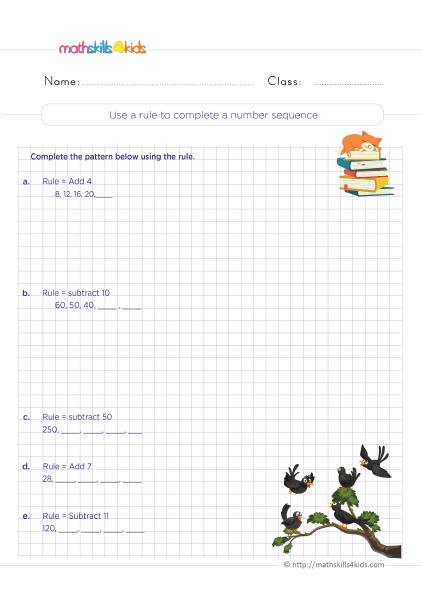 Print it...
Print it...
-
Comparing the pattern rule in a table practice
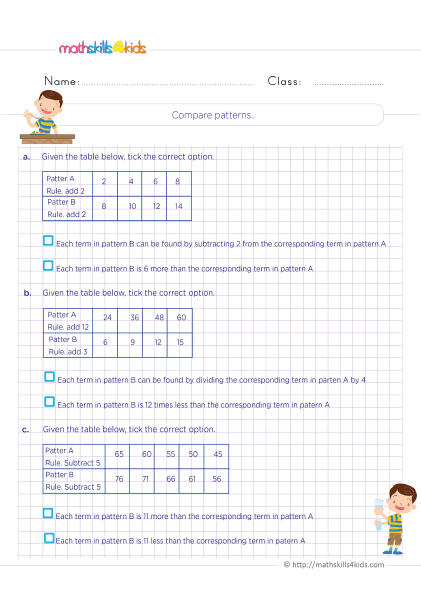 Print it...
Print it...
-
Completing an increasing number sequence
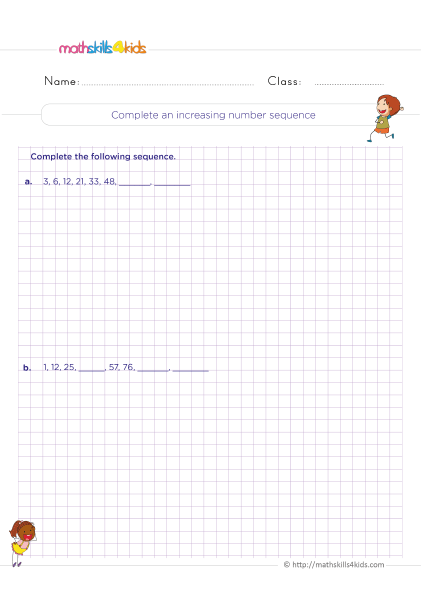 Print it...
Print it...
-
Completing a geometric number sequence
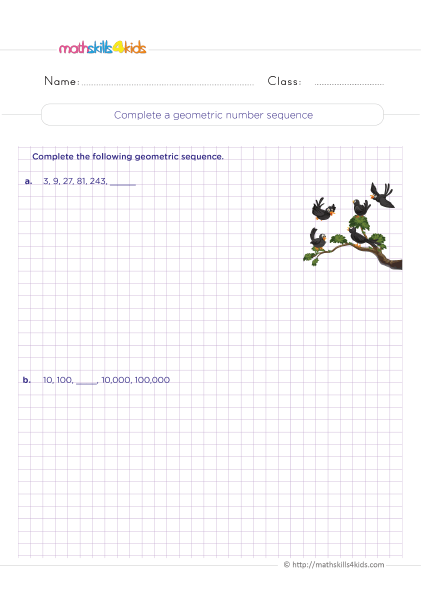 Print it...
Print it...
-
Sequence and series problems and solutions
 Print it...
Print it...
-
Number sequences mixed review
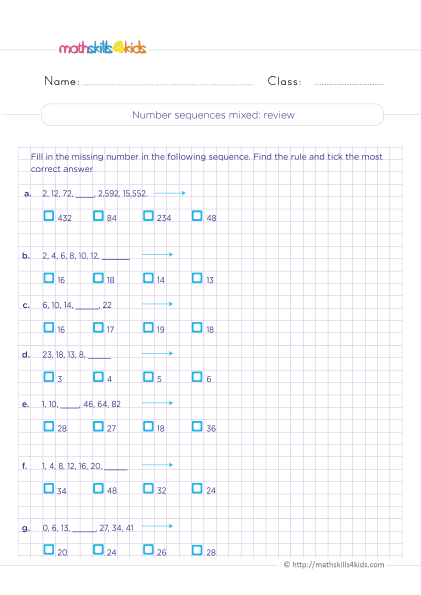 Print it...
Print it...
-
Complete an increasing number sequence using a rule
-
Buying is supporting us!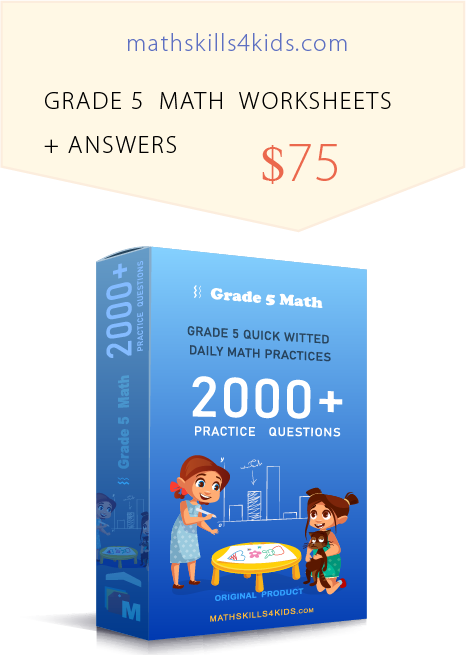
Buy Now...
-
-
How to teach number patterns in Grade 5?
Teaching number patterns in grade 5 can be fun and engaging using diverse methods and resources. Here are some suggestions:
- Use visual aids such as charts, tables, graphs, diagrams, or manipulatives to show how number patterns work and how they relate to other math concepts.
- Use concrete examples from real life or other subjects such as science or social studies to show how number patterns are helpful and relevant.
- Use games and puzzles such as Sudoku, magic squares, crosswords, or logic problems to challenge students to find and complete number patterns.
- Use songs or poems with number patterns like "One Potato Two Potato" or "Twinkle Twinkle Little Star" to help students remember and enjoy number patterns.
- Use calculators, computers, or apps to generate or explore number patterns.
- Use inquiry-based learning where students ask questions, make hypotheses, test their ideas, and share their findings about number patterns.
- Use cooperative learning, where students work in pairs or groups to investigate or create number patterns.
-
What are number sequences?
A number sequence is a list of numbers that follows a specific rule or order. For example, 1, 2, 3, 4, and 5 is a simple number sequence that follows the rule of adding 1 to the previous number.
Number sequences are similar to number patterns, but they have some differences. Number sequences usually have a starting and ending point, while number patterns can continue forever. Number sequences also have specific terms or positions, while number patterns can have any number of terms. For example,
1st term: 1
2nd term: 2
3rd term: 3
4th term: 4
5th term: 5
This is a way of describing the terms or positions of the number sequence above.
Number sequences can help you learn about arithmetic sequences (where each term is obtained by adding or subtracting a constant value), geometric sequences (where each term is obtained by multiplying or dividing by a constant value), Fibonacci sequence (where each term is the sum of the two previous terms), triangular numbers (where each term is the sum of all the natural numbers up to that term), square numbers (where each term is the square of a natural number), cube numbers (where each term is the cube of a natural number), and more.
-
Why number patterns and sequences are fun and easy to learn
Number patterns and sequences are fun and easy to learn because they appeal to our natural curiosity and sense of beauty. They also help us develop our logical thinking and problem-solving skills. Here are some reasons why number patterns and sequences are fun and easy to learn:
- They are everywhere. You can find number patterns and sequences in nature, such as the petals of a flower, the spirals of a shell, the spots of a leopard, or the rings of a tree. You can also find them in art, such as the symmetry of a painting, the rhythm of a song, the rhyme of a poem, or the shape of a sculpture. You can also find them in everyday life, such as the calendar, the clock, the phone number, or the license plate.
- They are surprising. You can discover unexpected and amazing facts about numbers by looking at their patterns and sequences. For example, did you know that every even number greater than 2 can be written as the sum of two prime numbers? This is called Goldbach's conjecture, and it has not been proven or disproven yet.
Or did you know that if you add up all the digits of any multiple of 9, you will always get 9? This is called the digital root of 9, a property of divisibility by 9.
- They are creative. You can use your imagination and creativity to make number patterns and sequences. For example, you can make a pattern using your favorite colors, shapes, or objects.
Or you can make a sequence using your name, birthday, or hobbies. You can also use different operations or rules to make your patterns and sequences more exciting or challenging.
-
How to use number patterns and sequences to solve problems and puzzles
Number patterns and sequences can help you solve problems and puzzles by giving you clues, strategies, or shortcuts. Here are some ways to use number patterns and sequences to solve problems and puzzles:
- Look for patterns or sequences in the given information or answer choices. For example, if you are asked to find the next term in a sequence, you can look for a pattern or a rule that connects the given terms. Or, if you are asked to choose the correct answer from a list of options, you can look for a pattern or a sequence that matches the question.
- Use patterns or sequences to make predictions or generalizations. For example, if you are asked to find how many dots are in a triangular arrangement of dots, you can use the pattern or sequence of triangular numbers to find the answer.
Or, if you are asked to find how many times a specific digit appears in a large number, you can use the pattern or sequence of digits to find the answer.
- Use patterns or sequences to check your answers or find mistakes. For example, if you are asked to add or multiply two large numbers, you can use the pattern or sequence of digits to check if your answer is correct. Or, if you are asked to find a missing term in a sequence, you can use the pattern or rule to check if your answer fits.
-
Examples of number patterns and sequences in nature, art, and music
Number patterns and sequences are useful for math and enable us to appreciate the beauty and harmony of nature, art, and music. Here are some examples of number patterns and sequences in nature, art, and music:
- Nature: One of the most famous examples of a number sequence in nature is the Fibonacci sequence. This is a sequence where each term is the sum of the previous two terms: 1, 1, 2, 3, 5, 8, 13, 21, 34, ... You can find this sequence in many natural phenomena, such as the arrangement of petals on a flower, the spirals of a pinecone or a sunflower, the scales of a pineapple, and the shape of a nautilus shell.
The Fibonacci sequence is related to another number pattern called the golden ratio, a unique proportion that makes things look pleasing to the eye. The golden ratio is about 1.618, and you can find it in many natural shapes, such as the human face, a butterfly's wings, and the wave's curve.
- Art: Many artists use number patterns and sequences to create masterpieces. For example, Leonardo da Vinci used the golden ratio to draw his famous painting of the Mona Lisa. He divided the painting into sections that followed the golden ratio, making it more balanced and harmonious.
Another artist who used number patterns and sequences was Piet Mondrian. He was inspired by geometry and used rectangles of different sizes and colors to create abstract paintings. He followed a rule that each rectangle had to be horizontal or vertical and that each color had to be red, yellow, blue, black, or white. He also used the golden ratio to arrange his rectangles nicely.
- Music: Music is also full of number patterns and sequences. For example, musical notes follow an octave pattern, a sequence of eight notes that repeat at higher or lower pitches. An octave's first and eighth notes have the same name, such as C or D. You can also find number patterns and sequences in musical rhythms and beats. For example;
A typical rhythm pattern is called 4/4 time, which means that each measure has four beats, and each beat has a quarter-note value. You can count this pattern as 1-2-3-4 or clap along with it.
Another typical rhythm pattern is called 3/4 time, which means that each measure has three beats, and each beat has a quarter-note value. You can count this pattern as 1-2-3 or clap along with it. Some songs use different rhythm patterns to create variety and contrast.
As you can see, number patterns and sequences are fun, easy to learn, and excellent ways to understand and appreciate the world around us. Above all, they help us see the beauty and order in nature, art, and music.
- Nature: One of the most famous examples of a number sequence in nature is the Fibonacci sequence. This is a sequence where each term is the sum of the previous two terms: 1, 1, 2, 3, 5, 8, 13, 21, 34, ... You can find this sequence in many natural phenomena, such as the arrangement of petals on a flower, the spirals of a pinecone or a sunflower, the scales of a pineapple, and the shape of a nautilus shell.
-
Mathskills4kids’ Tips and tricks to master Grade 5 fun and engaging number patterns and sequences worksheets
Grade 5 students might think that number patterns and sequences are hard to learn, but they are easy and fun once you know the tricks! Here are some tips and tricks from Mathskills4kids.com that are helpful to master Grade 5 math fun and engaging number patterns and sequences worksheets:
- Look for the rule. Every number pattern and sequence follows a rule that tells you how to get the next term from the previous ones. For example, in the pattern 2, 4, 6, 8, ..., the rule is to add 2 to the previous term.
Sometimes the rule is simple, like adding or multiplying by a constant. Other times, the rule is more complex, like using two operations or alternating between two rules. The key is to look for the pattern and figure out the rule.
- Use a table or a chart. A table or a chart can help your students organize the terms of a number pattern or sequence and see the relationship between them. For example;
They can make a table with two columns: one for the term number (n) and one for the term value (a). Then they can fill the table with the given terms and look for a pattern in the second column. They can also use a chart to plot the terms of a number pattern or sequence on a coordinate plane and see how they change as n increases.
- Use variables and expressions. Sometimes students can write the rule of a number pattern or sequence using variables and expressions. For example, if the rule is to add 3 to the previous term, they can write an expression like a(n) = a(n-1) + 3, where a(n) is the nth term and a(n-1) is the previous term. This way, they can find any term of the number pattern or sequence by plugging in different values of n.
They can also use variables and expressions to write a general formula for a number pattern or sequence, such as a(n) = 2n + 1 for the pattern 3, 5, 7, 9, ...
- Check your answers. Please encourage your students to check their answers when they work with number patterns and sequences. They can do this by plugging your answers into the rule or formula to see if they match the given terms.
They can also use logic and common sense to see if their answers make sense. For example, if you find that the next term of a pattern is negative, but all the given terms are positive, you might have made a mistake.
- Look for the rule. Every number pattern and sequence follows a rule that tells you how to get the next term from the previous ones. For example, in the pattern 2, 4, 6, 8, ..., the rule is to add 2 to the previous term.
-
Activities and games for 5th graders to practice number patterns and sequences with their friends
Learning number patterns and sequences is easy, fun, and very useful. We can use them to solve problems and puzzles, create art and music, and explore nature and science. Here are some activities and games that your students can do with their friends to practice number patterns and sequences:
- Fibonacci hopscotch. The Fibonacci sequence is one of the most famous number sequences in mathematics. It starts with 1, 1, and then each term is the sum of the previous two terms: 1, 1, 2, 3, 5, 8, 13, .... Students can make a hopscotch game using this sequence by drawing squares on the ground with chalk and writing the Fibonacci numbers inside them. Then hop on one foot from one square to another, following the sequence.
They can also make variations of this game by using different starting numbers or rules for generating the sequence.
- Pascal's triangle bingo. Pascal's triangle is a triangular array of numbers with many interesting patterns and properties. It starts with 1 at the top, and then each row is formed by adding the two numbers above it:
1
1 1
1 2 1
1 3 3 1
1 4 6 4 1
Students can make a bingo game using this triangle by making cards with different numbers from Pascal's triangle. Then they can draw numbers from a hat or a bag and call them out loud. The first person who has five numbers in a row on their card wins.
- Magic square challenge. A magic square is a square grid of numbers with the same sum for each row, column, and diagonal. For example, this is a magic square with a sum of 15:
8 1 6
3 5 7
4 9 2
Please encourage your students to challenge their friends to make their magic squares using different numbers or different sizes of grids. They can also try to find magic squares with other properties, such as being symmetric or having only prime numbers.
- Fibonacci hopscotch. The Fibonacci sequence is one of the most famous number sequences in mathematics. It starts with 1, 1, and then each term is the sum of the previous two terms: 1, 1, 2, 3, 5, 8, 13, .... Students can make a hopscotch game using this sequence by drawing squares on the ground with chalk and writing the Fibonacci numbers inside them. Then hop on one foot from one square to another, following the sequence.
Bonus: Interesting number patterns and sequences resources to boost your learning
If you want to learn more about number patterns and sequences, there are many resources that you can explore online or offline. Here are some of them:
- [Math is Fun] (https://www.mathsisfun.com/puzzles/number-sequences-solution.html): This website explains making magic squares. It also has interactive activities and puzzles that you can try.
- [Khanacademy] (https://www.khanacademy.org/math/arithmetic-home/arith-review-patterns): This website has videos and exercises that teach you how to identify and extend number patterns and sequences.
- [Splashlearn] (https://www.splashlearn.com/math/number-patterns-games-for-5th-graders): This website has games and quizzes that test your skills on number patterns and sequences.
-
Thank you for sharing the links of MathSkills4Kids.com with your loved ones. Your choice is greatly appreciated.
Conclusion: applying number patterns and sequences to real-life situations
Number patterns and sequences are fun to learn and useful in real-life situations. We can use them to:
- Predict future events or trends based on past data. For example, we can use number patterns and sequences to forecast the weather, the stock market, or the population growth.
- Create codes or passwords that are hard to crack. For example, we can use number patterns and sequences to make secret messages or encryption keys.
- Solve problems or puzzles that involve logic, reasoning, or creativity. For example, we can use number patterns and sequences to crack codes, find hidden clues, or make art.
Number patterns and sequences are everywhere in the world around us. They are beautiful, fascinating, and powerful. They can help us understand nature, science, art, music, and more. They can also help us improve our math skills, our thinking skills, and our problem-solving skills. They are fun and easy to learn with the right tips and tricks.
So what are you waiting for? Visit Mathskills4kids.com and download premium Grade 5 math fun & engaging number patterns and sequences worksheets and start practicing with your students today while having fun.
